Waste Not, Want Not: Grand Tajiguas Project Turns Proverb into Reality
Making Trash Is Easy; Dealing with It Is Not
By Jean Yamamura | July 29, 2021
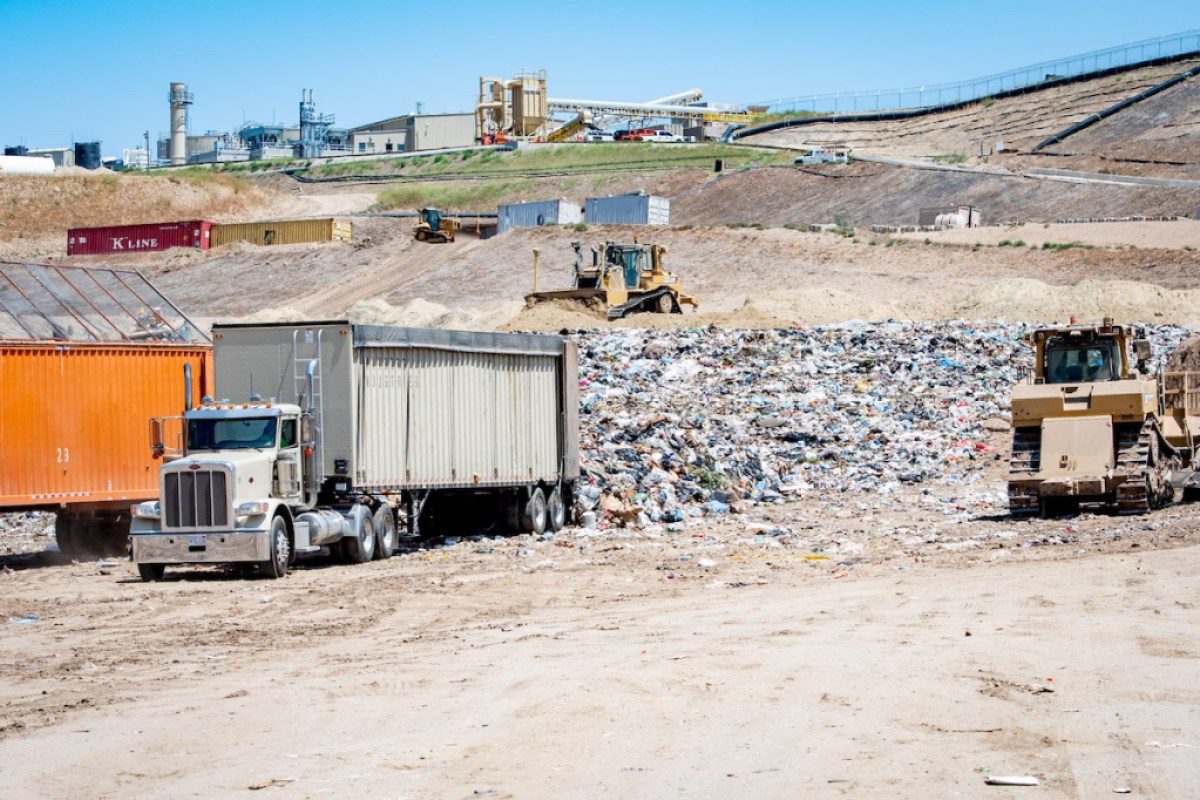
The ancient art of alchemy has been revived at the dump where Santa Barbara throws its trash. It’s propelled by a giant maze of conveyor belts that drops big, heavy trash and separates it from smaller, lighter trash and is also brewed in a concrete bunker where 16 heated tunnels take organics from the waste and turn them into black gold, or nutrient-rich compost.
Soon, much of the 200,000 tons that get trucked through the gates at Tajiguas Landfill every year will be converted into the electricity necessary to run the extensive facility with enough left over to power 3,000 homes. And the amount of trash plowed under at the site will be reduced by more than 85 percent.
The landfill, 26 miles up the coast from Santa Barbara, has become the first in California to combine all these beneficial waste-stream elements — a recycling center, an anaerobic digester, and a composting facility — at one site. First dubbed the Materials Recovery Facility, or MRF (pronounced “merf”), it is now known as the ReSource Center.
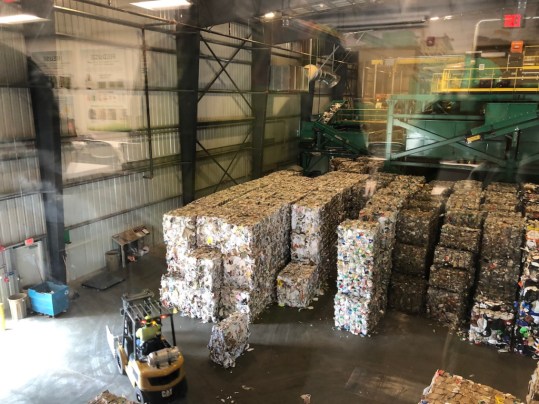
Making trash is easy; dealing with it is not. In the late 1990s, the County of Santa Barbara faced shrinking available space at the landfill. Tajiguas had been given a 100-year lifespan when it opened in 1967. Within 32 years, however, it had hit the half-full mark; the county faced either expanding the landfill or transporting the trash farther away by 2004, possibly to Santa Maria or Simi Valley. Further, the State of California was mandating that 50 percent of trash be diverted into recycling or other conversions, and Tajiguas was only diverting about 25 percent.
At the ribbon-cutting for the new complex on July 16, U.S. Congressmember Salud Carbajal recalled the many county supervisors who’d participated in the uphill battle to win public support to spend $150 million to develop the MRF. One was the late Naomi Schwartz, for whom Carbajal had been chief of staff before winning her seat when she retired. Former supervisors Doreen Farr, Susan Rose, and Janet Wolf were others, but he especially recalled Brooks Firestone, a Republican supervisor from the 3rd District, where Tajiguas is found. He and Firestone had anchored a multijurisdictional task force that “was like herding cats,” said Carbajal, and included representatives from the cities involved — Santa Barbara, Solvang, Buellton, and Goleta; another 15 people were on a citizens advisory committee.
“It took an effort to bring everyone together,” Carbajal later told the Independent. Given the volatility of recyclable commodities, every time the markets dipped, the cohort worried they’d get stuck with the project, he said. Supervisor Das Williams, who now occupies Carbajal’s 1st District supervisor’s seat, agreed, recalling from his years on Santa Barbara’s City Council that there was uncertainty about the stream of trash going to Tajiguas and whether it would create enough feedstock for the hoped-for recycling and composting benefits.
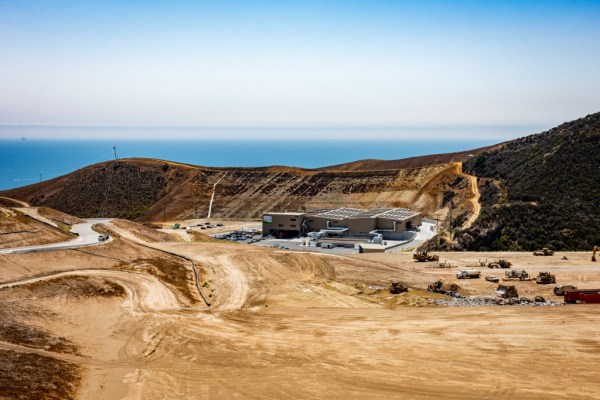
“The gamble was predicated on payment of the bonds,” Carbajal explained. The $150 million was raised through a bond issue: $135 million for the MRF and the remainder to buy adjoining properties and avoid landfill nuisance complaints. “And the tipping fees were key,” Carbajal added — the charge per ton to offload trash at Tajiguas — “as that was what was going to pay for this on an ongoing basis. The cities had to commit to the facility. That was fundamental.” But it was a big commitment: “Everyone was being asked to agree to all the terms, all the risk…. Everyone was a little queasy on whether this was the right thing to do.”
Given the Washington, D.C., climate Carbajal moves in now, he recalled the good faith everyone showed and the trust they had that the county was being honest in its projections. They demonstrated it by signing on the dotted line. “This will be a model of best practices for our country,” he said expansively of the new facility, citing the innovations and new technology it put into practice. “It’s great for addressing climate change through all the methane that won’t go into the air, the renewable energy we’re getting out of this, and the ability to divert trash from the landfill without the necessity of expanding it.”
That’s a necessity that’s only about a decade away, and trash production in Santa Barbara keeps going up. “During COVID alone, the amount of cardboard we discarded went up 30 percent in the county,” Williams said. The aftermath of the Great Recession was the only time the tons of garbage went down.
Unlikely Home
The 357-acre landfill spreads across a small canyon in an unlikely area: the Gaviota Coast, a landscape of unparalleled natural beauty and wild diversity. Trash takes up a footprint of about 118 acres and has been terraced and bench-filled to maximize its bounds. Purposefully, the sculpted hills of waste and dirt cannot be seen from Highway 101, a good quarter-mile from the terraformed earthworks.
When it comes to a landfill and the environmental consequences of what lies below, the struggle has been to find the right solution and the daunting price tags involved. Following an expansion in 2002 into an upper portion of the canyon, the best estimate of how much the new ReSource Center will lengthen the life of the landfill is 10-15 years. But it allows Santa Barbara to “take responsibility for its own waste material,” said Leslie Wells, who has worked on the Tajiguas project since 2006 and now heads the county’s Resource Recovery division. “We are going to manage our own waste in our own county and turn it into benefits for the community,” she told the crowd at the MRF on July 16.
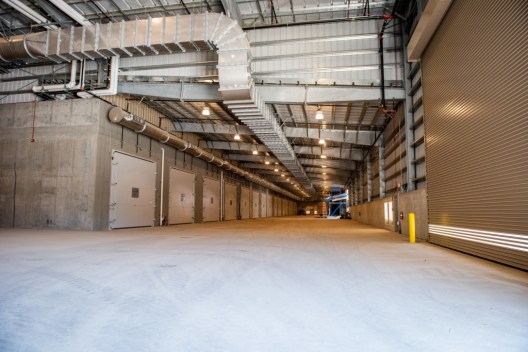
The flip side of that goal is a “do no harm” effort for the watershed. When it rains, Pila Creek drains the upper watershed of the canyon, which has no natural spring, said Carlyle Johnston, project leader for the ReSource Center. Where the creek crosses into the landfill, it’s channeled into a pipe buried under all the trash and emerges near the highway before it drops down to the Pacific Ocean, he explained. In his 19 years with Public Works’ Resource Recovery division, Johnston said they’ve given 150 public presentations about the project. He’s told the Tajiguas story in all its detail over 100 times.
The mountains of trash rise to about 600 feet, and any surface water runoff is funneled into a pond and tested. The old part of the landfill sits on Rincon shale, Johnston said, explaining that the formation creates a natural barrier between the trash and groundwater. Santa Barbara County’s dry climate means little rain falls or percolates through the layers to speed the breakdown of trash into methane, the worst of the greenhouse gases.
The newer part of the landfill is lined with plastic. At any one time, the open face of the landfill is just a couple hundred feet of trash, which is pushed into a 22-degree angle before being covered with dirt by giant backhoes. After testing, the water from the pond is sprayed to keep the dust down.
Nearby, Dave Roth was parked with a falcon. A falconer and a predatory bird have been onsite at Tajiguas since 2002 to keep the seagull population in check. Just flying the raptor was enough to send the seagulls scattering, said Johnston, and none were in sight. At their height, about 4,000 gulls scavenged at the trash site; they then would gather at Arroyo Quemada Beach, sending ocean-water fecal counts soaring. Both the seagull population and the poop microbes dropped dramatically once Roth and his “muse” of falcons were hired.
It’s Black Gold
The “out of sight, out of mind” approach that most of us take to our trash predates home garbage pickups. Early Santa Barbarans sank their trash into a lagoon that flowed several blocks toward town from the ocean, and they eventually filled it with debris from the 1925 earthquake. Bits and pieces still turn up when a development in the coastal zone digs a foundation. The land under Elings Park was once the city dump before Tajiguas was created to hold both city and county waste.
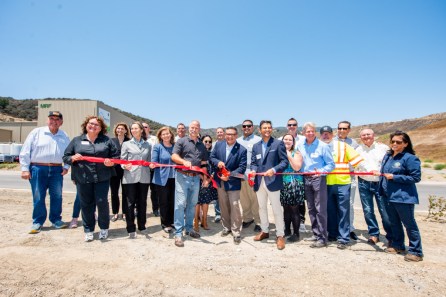
Trash heaps can catch fire or explode from the heat generated as organics break down into methane, and the hills at Tajiguas — old and new — are plumbed for methane extraction. Some landfills still use flares to burn off excess biogas, but the new state-of-the-art anaerobic digester installed and heated to an optimum temperature at Tajiguas is expected to consume 99.9 percent of the methane produced by the organic trash.
Operations at the ReSource Center go like this:
As trash from MarBorg’s brown bins rumble up a crisscrossing maze of conveyor belts — with machines from the Netherlands, Germany, Spain, and elsewhere organized to puff air to move plastics and dry paper in one direction and magnets and “Eddy current” to move metals and aluminum in another — what drops down into bins are food waste and wet or dirty paper that get sent to the anaerobic digester.
The ReSource Center employs 20 people to stand watch and pull out strays along the pathways to ensure the recycling bales are clean and marketable. Giant silver air ducts siphon the upper reaches of the building into two large filtering tanks full of dampened wood to create a negative-pressure space; the system maintains air quality for the workers and helps eliminate odors from a building full of garbage.
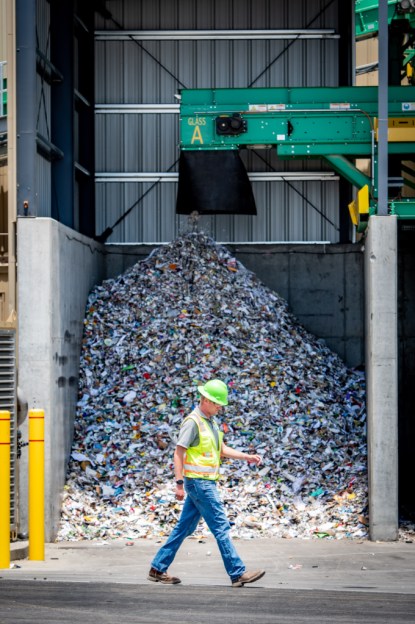
Recyclables from blue bins occupy the conveyor belts at different times from the trash, Johnston explained. Not only is the sorting simpler — and easily adjusted on the new machines — but when consumers separate recyclables from trash, the recycled materials stay clean, very important when it comes to cardboard and paper. “Cardboard sells for about $150 a ton,” he said. “When it’s contaminated with food, it’s worth less.”
At the anaerobic digester — a low-slung concrete structure with 16 airtight bunkers — the first batch of organics is mixed with 3 percent cow manure and heated to 104 degrees Fahrenheit for 28 days. The watery muck is like sourdough starter in that the resulting bacteria soup is self-perpetuating. It resembles a black sludge that smells terrifically of ammonia and cat urine, said Johnston.
Once combined with green waste — which is also chopped and separated at Tajiguas — and set out in windrows on an asphalt plain the size of a soccer field, six to eight weeks later, the result is a compost that would make a farmer cry. The rich mix, when applied to topsoil, holds in moisture and promotes the growth of whatever it touches: grasses, crops, orchards, gardens, and the microbes that live in a healthy soil community.
The methane that off-gases as the organics break down is pure energy — and an extremely harmful one in terms of greenhouse gases. According to the EPA, methane is 25-100 times more planet-warming than carbon dioxide, said Johnston. Burned in gas engines, methane that flows out from the landfill and the digester creates the energy the ReSource Center runs on, and the excess goes to the electrical grid. Once burned, the methane is reduced to carbon dioxide.
Cuts Greenhouse Gas
One short week after the July 16 ribbon-cutting, the anaerobic digester was set to preheat. It was to ingest its first load of material the month after. When the facility is fully up and running, 40 percent or more of the waste taken to Tajiguas will end up in the digester, Johnston said.
Germany has about 9,000 anaerobic digesters like this one, said John Dewey, head of Mustang Renewable Power Ventures, the lead contractor that put both the facility and the financing together. California has 22. Santa Barbara’s is the first facility to host all the elements — from the waste mixture to compost production — in one place. “It goes from farm to table and back to the farm in a healthy soil cycle,” Dewey said.
The end result is a clean-energy facility that contributes the single greatest reduction of greenhouse gases in the county, said 3rd District Supervisor Joan Hartmann. She marveled that Tajiguas now turned a liability into an asset — namely, converting tons of trash into saleable recyclables, compost, and energy every year — and into agriculturally valuable compost. The decade or more of life this all will add to the landfill is necessary; tons of trash that cannot be recycled or digested anaerobically continues to come through its gates in MarBorg trucks seven days a week.
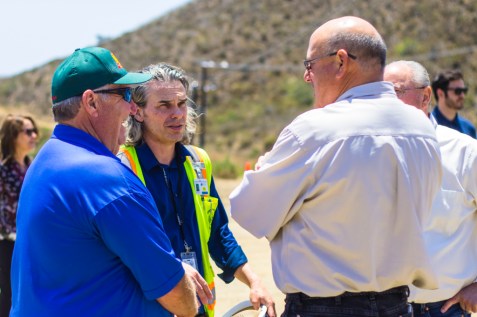
Roughly 20 percent is pulled out as recyclables, such as glass, metals, number 1 and number 2 plastics, and dry cardboard and paper. An important benefit they’d found, said Johnston, is that the magnetic sorters capture any batteries thrown into the trash. Tajiguas doesn’t accept hazardous waste such as batteries or medical waste.
Plastics are considered among the worst of modern products now, Johnston said, pointing out bales of thin-film plastics on the ReSource Center floor destined for the landfill. They baled them to make sure none got caught in the wind and sailed out to sea. When they sold the plastics, they tried to find buyers and remanufacturers in California. Number 1 plastics reappear in grocery stores as clamshell berry boxes made in California, for instance, and number 2 plastics are currently reprocessed into detergent bottles.
Number 2 and number 5 plastics sometimes go to Malaysia, where they are made into rigid plastics, and Vietnam takes most of Santa Barbara’s paper. Water is the big issue for paper, Johnston said, and they were waiting for the mills in the northwest to open again. The markets change constantly, he added, which is why people will find certain plastics absent from the recyclables list at the county’s lessismore.org resource recovery website from time to time.
Don’t Buy Stuff
Das Williams was in a “let’s cut the BS” frame of mind a week after the ribbon cutting. “This is the greatest victory we’ve ever had in reducing methane greenhouse-gas emissions in this community,” he said. However, “our understanding of solid waste really undermines the picture of ourselves as paragons of environmental conscience.” Local solutions to waste were fundamental, and he found it environmentally irresponsible to even consider trucking South County’s trash to Santa Maria.
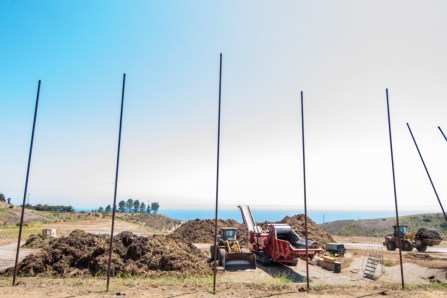
At the City of Santa Barbara, Williams said, “we even got to 70 percent diversion, but we never reduced by one ton the amount of trash going into the landfill compared to when we recycled zero. The reason is the wastefulness of our lifestyle and our affluence, which has kept pace with our ability to recycle.” Part of the point of the Education Center at Tajiguas was to show where the recyclables go, he noted. “Right now, the demand for recycled materials demonstrates how hot the economy is,” he cautioned. “We have to be conscious of that in the long run, too.”
He had praise for the anaerobic digester, which if anything has been undersold. “If the compost it produces is used for any agricultural purpose, then the carbon farming, the carbon fixing, the water saving the compost does will reduce emissions even more.”
Reducing pollutants is huge, Williams said, but ultimately, “so much of what needs to be accomplished to save our environment is driven by the choices of individuals, what they choose to buy, what they choose to drive, what they choose to do.”
Johnston couldn’t agree more. He noted that the “Reduce, Reuse, Recycle” slogan has outlived its purpose, as the landfill and the planet near the tipping point.
“Recycling is cool, but cool as it is, it’s better not to buy stuff.”
Correction: This story was revised on July 29 to reflect that methane is 25-100 times more potent a GHG as carbon dioxide, not percent; Elings was a city dump; and the project design superintendent’s name is David Poorbaugh.




You must be logged in to post a comment.